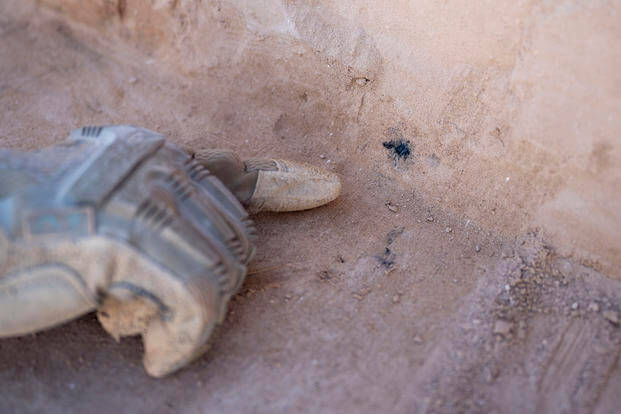
About 8,200 years ago, the worst of the Ice Age was over.
In some parts of the planet, hunting and gathering were beginning to give way to agriculture, as the Pleistocene Epoch slipped into the Holocene.
Southwestern Pueblo cultures had yet to emerge, and Stonehenge was still just a twinkle in some prehistoric forebear’s eye. But people were already occupying the sites of several of the oldest cities in the world — the precursors of Jericho on the West Bank, Damascus in Syria.
And at a now-windswept spot in Southern New Mexico, somebody was using a hearth.
A number of somebodies, actually, on potentially a whole series of hearths.
An uncommonly well-preserved campsite believed to date back more than eight millennia has been found deep in the ground on Holloman Air Force Base, near Alamogordo. The site — where geomorphologists and members of the 49th Civil Engineer Squadron environmental flight discovered about 70 items, ranging from a series of hearths to an early version of a stone pestle — could offer valuable information about how prehistoric people in the Southwest survived and adapted to climate change in their time, said Matthew Cuba, the squadron’s cultural resource manager.
“It’s significant because we have very few intact sites from this time period because … of the erosional nature of a desert environment,” Cuba, 43, said in an interview Monday. “… This is a situation in which the site retains a high degree of integrity.”
The site, which officially bears the not-so-snappy moniker of “LA202921,” is more colloquially known as the “Gomolak Overlook,” a nod to Holloman’s longtime cultural resources manager and Cuba’s own predecessor, J.R. Gomolak, who is now retired.
It was first discovered a little less than a year ago when two scientists from the University of Arizona, who Cuba said were “looking for soils” on an unrelated mission, spotted something unusual.
“They were driving down the road and they said, ‘Oh, look, there’s an artifact exposed in the road cut,'” Cuba said. “And that’s how it all started … believe it or not.”
The University of Arizona researchers, Vance Holliday and Jason Windingstad, notified Cuba, whose civilian role includes ensuring compliance with the National Historic Preservation Act, a ’60s-era measure that requires the federal government to inventory and evaluate all archaeological sites discovered on federally managed land. The artifact ended up being a “mano” — part of an ancient version of a mortar-and-pestle.
That led to the eventual unearthing of the Gomolak Overlook campsite, two meters below the ground’s surface. There researchers discovered about 70 items, including flake stones, a series of hearths or community campsites, and the remains of mesquite charcoal that helped researchers determine the age of the site.
Cuba said the campsite would have been built by “paleoarchaic” people — some of the earliest human settlers in what’s now considered the continental U.S. The group at the Gomolak Overlook would have been in the process of adapting to the changes in climate during the Holocene Epoch, which in the Southwest region would have meant weather generally getting warmer and drier.
“It’s not very different than what we’re kind of dealing with today in terms of environmental change,” Cuba said. “Their ability to find food, thrive and survive was changing. … I would argue since … people continued to live in Southern New Mexico for the next 8,000 years, they did a pretty good job of it.”
Cuba said it’s too early to know much about the people who built the campsite or what they were doing there — whether they were actually cooking on those hearths, for example.
“There’s a good chance they were cooking over it, but we don’t have the full picture yet,” he said.
Cuba said a particular set of environmental factors must have aligned for the Gomolak Overlook to stay in such good shape as New Mexico’s Tularosa Basin — which back then likely would have been a bit wetter and cooler — grew hotter and drier over thousands of years. The same events that created the White Sands dune field to the west also were responsible for the formations on Holloman Air Force Base, he said. But while the dunes were formed from the “heaviest portion,” deposits of lighter soil material gradually covered the Gomolak Overlook campsite.
“It’s kind of a Goldilocks situation,” Cuba said. “It happened just fast enough to preserve it, but not too fast.”
Cuba said for now the U.S. Air Force will block off and protect the site. Archaeological contractors will come out to ascertain how extensive the campsite is, and then the base will consult with the state Historic Preservation Division to figure out how to proceed.
Cuba said the site, which joins about 400 archaeological discoveries at Holloman, has the potential to offer major insights into the ancient world.
“The archaeological record is so fragmented that far back,” he said. “When you’re looking at much younger sites … a lot more of them have survived for us to be able to study.”
(c) 2024 The Santa Fe New Mexican (Santa Fe, N.M.)
Visit The Santa Fe New Mexican (Santa Fe, N.M.) at www.santafenewmexican.com
Distributed by Tribune Content Agency, LLC.
© Copyright 2024 The Santa Fe New Mexican. All rights reserved. This material may not be published, broadcast, rewritten or redistributed.






